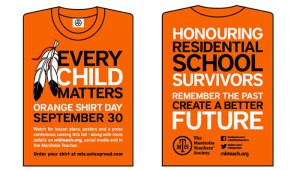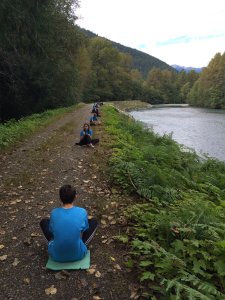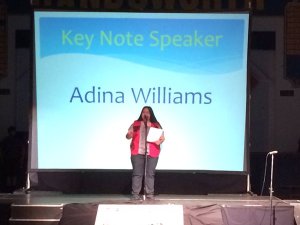This past Friday was the fourth annual “Orange Shirt Day” in schools across BC. This annual observance, coupled with the ushering in of BC’s new curriculum provides a wonderful opportunity to reflect on the movement to indigenise education.
Orange shirt day began in 2013 as a day to highlight the terrible treatment of First Nations students in residential schools across Canada. It was inspired by Phyllis Webstad, a Stswecem’c Xgat’tem First Nation elder in Williams Lake, BC, and by her experience at residential school in 1973, when she was only 6 years old. As a young girl, upon entering the school, she was stripped of her prized orange shirt. Similarly, the identity of many First Nations students was stripped away as a result of their horrible experiences in residential schools across the country.

Many people in North Vancouver don’t realize we had our own residential school here in our community. More than 2000 First Nation students were sent to St. Paul’s Indian Residential school, which was once located on Keith Road where St. Thomas Aquinas school now stands today. I think it’s important to know, as a North Vancouverite, that these schools were not just in far-flung, remote locations, but were embedded and accepted in our very own community at one time.
The recent move to indigenize BC’s curriculum came about in response to Canada’s Truth and Reconciliation Commission’s 94 ‘calls to action’. These 94 policies and programs are intended to help repair the harm caused by residential schools and move our communities forward with the reconciliation process.
Among the calls to action included points specific to education, including making, “age-appropriate curriculum on residential schools, Treaties and Aboriginal peoples’ historical and contemporary contributions to Canada a mandatory education requirement,” and, “developing and implementing … curriculum and learning resources on Aboriginal peoples in Canadian history, and the history and legacy of residential schools.”
And so this year we continue our good work to try and find ways to incorporate indigenous teachings and ways of learning. It’s a sensitive task, and one that I believe deserves our most earnest and honest efforts. The path, however, is far from straight. There are examples that illustrate how muddled the path can become, such as Ecole Lajoie in Montreal where teachers and grade 3 students learning about indigenous history were given headdresses to wear. Unbeknownst to those teachers, it is seen as disrespectful for non-First Nations people to wear headdresses, as there is a cultural and spiritual significance associated with them. This is not to suggest, however, that we shouldn’t be trying. Sometimes we are too afraid of offending or saying the wrong thing that we do nothing. Having good intentions is noble, but it is equally as important to make sure the steps we are taking are culturally sensitive and authentic means of closing the reconciliatory gap.

So what are some positive ways we can genuinely contribute to this process of indigenizing education for our students? To provide us with inspiration, we can begin by examining the 8 aboriginal ways of learning. This is a pedagogical framework that allows teachers to include aboriginal perspectives by using aboriginal learning techniques, and includes the following:
- Story Sharing: Approaching learning through narrative.
- Learning Maps: explicitly mapping or visualizing processes.
- Non-Verbal: Applying intra-personal and kinesthetic skills to thinking and learning.
- Symbols and images: Using images and metaphors to understand concepts and content.
- Land-links: Place-based learning, linking content to local land and place.
- Non-linear: Producing innovations and understanding by thinking laterally.
- Deconstruct / Reconstruct: Modeling and scaffolding, working from wholes to parts. Begin with the whole structure, rather than a series of sequenced steps.
- Community Links: Centering local viewpoints, applying learning for community benefit.
Some of these techniques you likely already recognize from your own classroom, or other classrooms you’ve been in. I recently had a conversation with a friend of mine taking his MBA at Simon Fraser University and he was telling me how his first class on leadership was all about the power of story telling, and how leaders can communicate messages more clearly and memorably through story. It struck me as interesting how one of the most rigorously academic programs one can take draws inspiration, perhaps unknowingly, from aboriginal oral tradition.

Simply being aware of the aboriginal ways of learning has allowed me to recognize it much more often in the daily teaching and learning practices I observe. Two weeks ago our school hosted a retreat for grade 8 students just entering high school. We took them up to our local outdoor school in Cheakamus for an overnight camp experience filled with workshops, many of which were infused with aboriginal ways of learning. In one exercise the students sat quietly, spaced out from their peers, drawing a sound map using symbols to represent what they heard around them. It was such a great activity, and blended so many of the ideas of aboriginal teaching together by being non-verbal, connecting with nature, using symbols and images, and by writing on a learning map. Not to mention the meditative qualities and social-emotional benefits that space and silence in a natural setting with peers provided.

Other examples in recent memory have been even more overt. At our schools “Heart Talks” assembly last year we had a remarkable keynote speaker named Adina Williams come and share her story of growing up as a member of the Squamish Nation in North Vancouver. We also had some of our English 11 classes learn a few words and phrases in traditional Squamish language. What an incredibly authentic learning experience, and a great opportunity for local First Nation youth to take a leadership role and pride in sharing their ancestral language. Yet another central tenet of aboriginal ways of learning relates to experiential learning – a concept I’ve already blogged about recently as an important way to connect students learning to their surroundings. These are all remarkable ways to help build community understanding and make a tangible effort to bridge that reconciliatory divide.
I’ve been trying to think of new and different ways to engage students in thoughtful reflection of the importance of learning about aboriginal communities, and in doing so have realized that the circumstances we find ourselves in are actually replicated similarly in other areas of the world. The past two summers I’ve taken students on study abroad tours to Australia, where the indigenous aborigines there have also suffered through generations of mistreatment, which to some extent still continues today. And the students who were with me were instantly able to recognize the parallels between aborigine and First Nation communities. On a related note, for the past 7 years I’ve also led our school’s annual Japan exchange. This year, and for the first time in over 25 years of its existence, I have altered our trip itinerary with the express purpose of exploring indigenous culture in Japan. Our route this year will now take us northwards to Hokkaido where we learn about the culture and traditions of Japan’s first people – the Ainu. It is my hope that we can, with our students, draw more parallels between the indigenous culture we find there and some of the traditions and ways of learning we see in First Nations culture. I’m excited to use this as yet one more opportunity to broaden students’ understanding of First Peoples.
The benefits to teaching using aboriginal ways of learning are many, and go far beyond the moral duty we have to try and heal our communities. One of the most important elements, I believe, is that the development of empathy in students can benefit everyone as we foster a more caring, peaceful and civil society.
The indigenization of education in BC through the new curriculum will take on many forms. It’s important that we, as educators, and indeed as a wider community, continue to make every effort to build bridges and reconcile ourselves with our First Nations neighbours. Indigenous ways of learning are one way we can start that process in our schools. As an educator I’m excited to see where this conversation takes us and am confident it will be, invariable, to a better place.
[…] year I wrote a blog post on the indigenisation of education in BC and mentioned in it how I hoped to infuse more indigenous ways of learning into my practice. Having […]
LikeLike